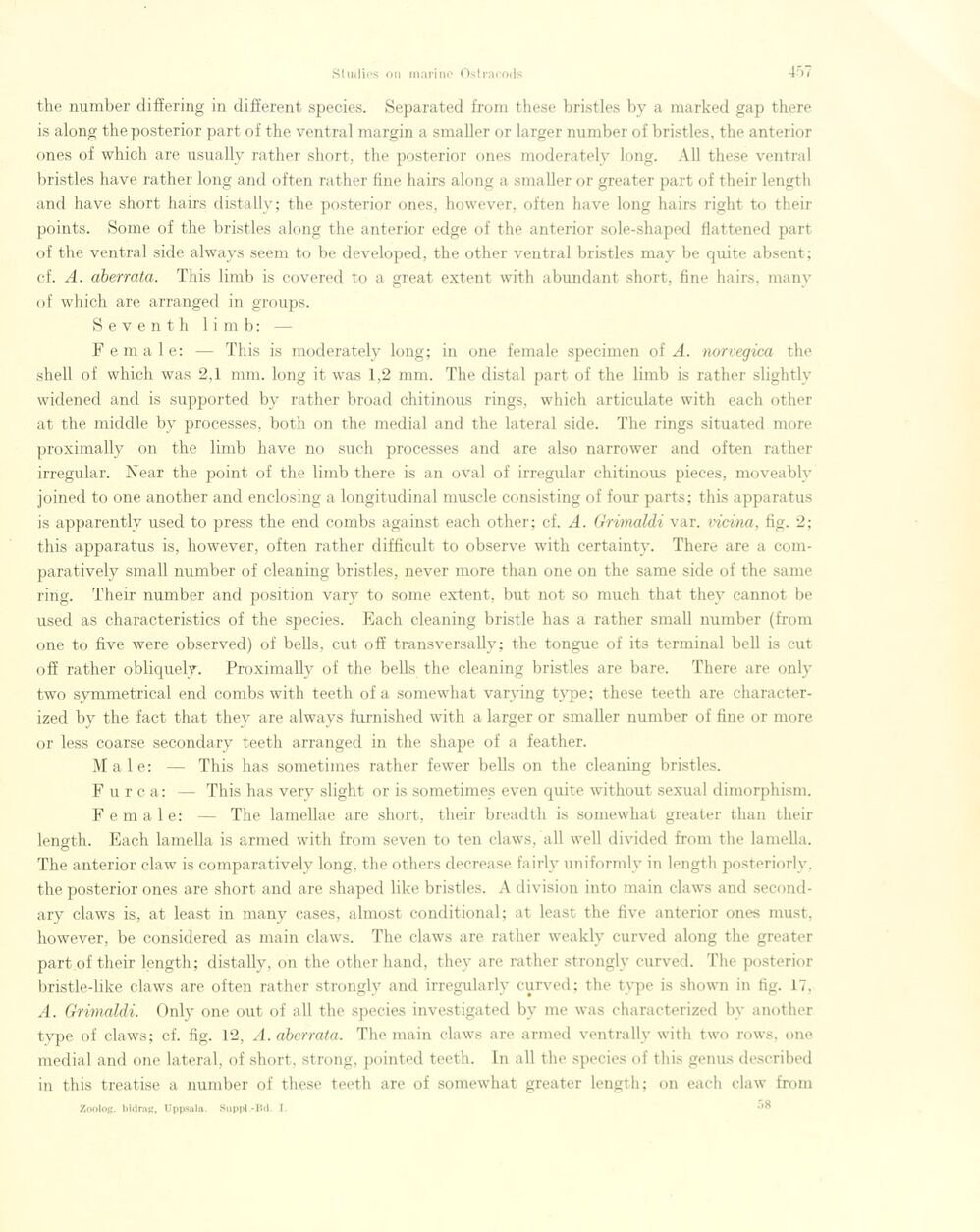
Full resolution (JPEG) - On this page / på denna sida - Sidor ...

<< prev. page << föreg. sida << >> nästa sida >> next page >>
Below is the raw OCR text
from the above scanned image.
Do you see an error? Proofread the page now!
Här nedan syns maskintolkade texten från faksimilbilden ovan.
Ser du något fel? Korrekturläs sidan nu!
This page has never been proofread. / Denna sida har aldrig korrekturlästs.
the number differing in different species. Separated from these bristles by a marked gap there
is along the posterior part of tke ventral margin a smaller or larger number of bristles, the anterior
ones of wliich are usually rather short, the posterior ones moderately long. All these ventral
bristles have rather long and often rather fine hairs along a smaller or greater part of their length
and have short hairs distally; the posterior ones, however, often have long hairs right to their
points. Some of the bristles along the anterior edge of the anterior sole-shaped flattened part
of the ventral side always seem to be developed, the other ventral bristles may be quite absent ;
cf. A. aberrata. This limb is covered to a great extent with abundant short, fine hairs, many
of which are arranged in groups.
Seventh limb: —
Fe ma le: — This is moderately long; in one female specimen of A. norvegica the
shell of which was 2,1 mm. long it was 1,2 mm. The distal part of the limb is rather slightly
widened and is supported by rather broad chitinous rings, which articulate with each other
at the middle by processes, both on the medial and the lateral side. The rings situated more
proximally on the limb have no such processes and are also narrower and often rather
irregulär. Near the point of the limb there is an oval of irregulär chitinous pièces, moveably
joined to one another and enclosing a longitudinal muscle consisting of four parts; this apparatus
is apparently used to press the end combs against each other; cf. A. Grimaldi var. vicina, fig. 2;
this apparatus is, however, often rather difficult to observe with certainty. There are a
coni-paratively small number of cleaning bristles, never more than one on the same side of the same
ring. Their number and position vary to some extent, but not so much that they cannot be
used as characteristics of the species. Each cleaning bristle has a rather small number (from
one to five were observed) of bells, cut off transversally; the tongue of its terminal bell is cut
off rather obliquely. Proximally of the bells the cleaning bristles are bare. There are only
two symmetrical end combs with teeth of a somewhat varying type ; these teeth are
character-ized by the faet that they are always furnished with a larger or smaller number of fine or more
or less coarse secondary teeth arranged in the shape of a feather.
M ale: — This has sometimes rather fewer bells on the cleaning bristles.
Furca: — This has very slight or is sometimes even quite without sexual dimorphism.
Female: — The lamellae are short, their breadth is somewhat greater than their
length. Each lamella is armed with from seven to ten claws, all well divided from the lamella.
The anterior claw is comparatively long, the others decrease fairly uniformly in length posteriorly.
the posterior ones are short and are shaped like bristles. A division into main claws and
secondary claws is, at least in many cases, almost conditional; at least the five anterior ones must,
however, be considered as main claws. The claws are rather weaklv curved along the greater
part of their length; distally, on the other hand, they are rather strongly curved. The posterior
bristle-like claws are often rather strongly and irregularly curved; the type is shown in fig. 17,
A. Grimaldi. Only one out of all the species investigated by me was characterized by another
type of claws; cf. fig. 12, A. aberrata. The main claws are armed ventrally with two rows, one
medial and one latéral, of short, strong, pointed teeth. In all the species of this genus described
in this treatise a number of these teeth are of somewhat greater length; on each claw from
58
Zoolog, bidrag’, Uppsala. Suppl.-Bel. I.
<< prev. page << föreg. sida << >> nästa sida >> next page >>